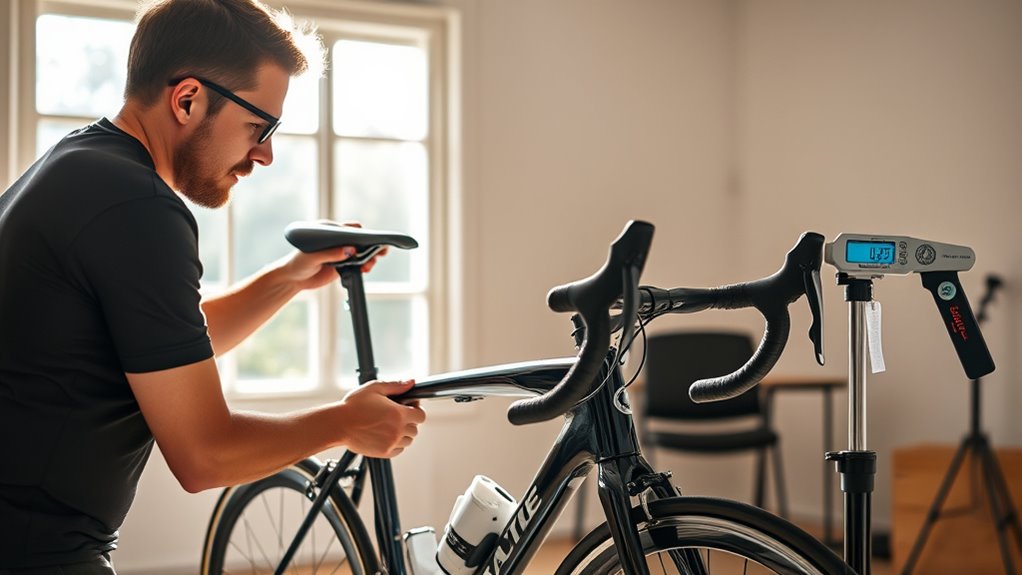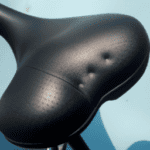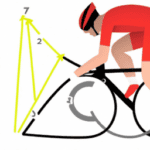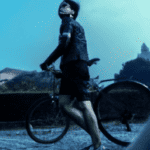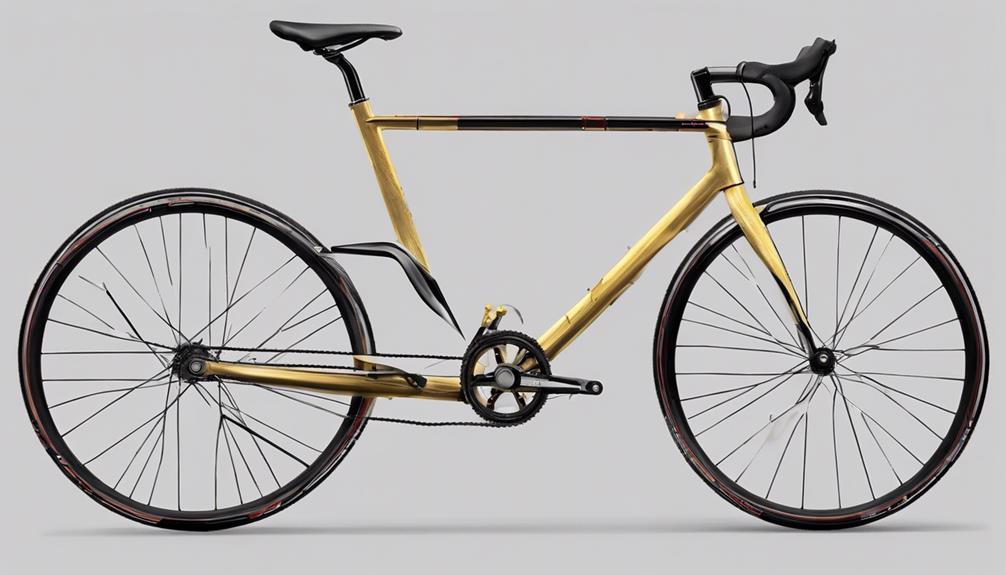You should consider seeking a professional bike fitting if you feel persistent discomfort, pain, or numbness during or after rides, especially if DIY adjustments don’t help. It’s also important if you’ve recently changed your body shape, flexibility, or bike components, or if you’re preparing for long-distance or competitive rides. If injuries or physical limitations affect your riding, a professional fit can help. Keep exploring to learn more about when expert advice can improve your cycling experience.
Key Takeaways
- Persistent pain or discomfort during or after rides indicates the need for a professional fit.
- DIY adjustments failing to resolve saddle sores, knee tracking, or numbness suggest seeking expert help.
- Experiencing numbness, tingling, or nerve compression signs warrants a professional assessment.
- Significant body changes, injury recovery, or mobility issues require professional fitting to prevent injury.
- Preparing for long-distance or competitive events benefits from a professional fit to optimize comfort and performance.
Experiencing Discomfort or Pain During Rides
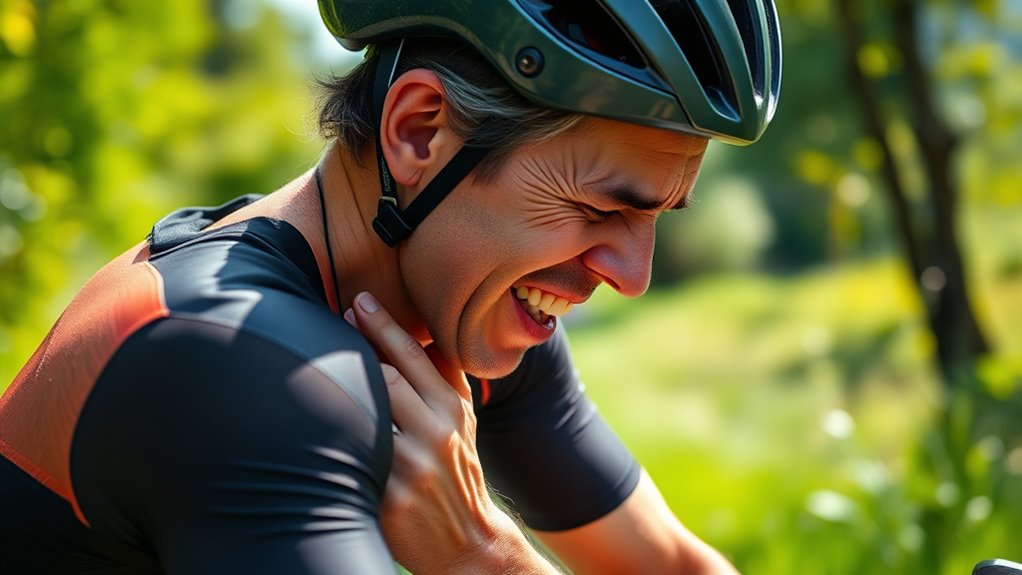
Experiencing discomfort or pain during rides is a common issue many cyclists face, often stemming from improper bike fit. You might notice lower back pain caused by saddle height or position, or knee pain from misaligned saddle or cleats.
Shoulder discomfort can result from leaning too much on the handlebars due to incorrect handlebar height. Saddle discomfort may occur if the saddle shape or size doesn’t suit your body, especially if you have wide sit bones.
Neck pain often stems from poor posture and handlebar placement. Recognizing these issues early is vital because persistent pain—like knee, back, or saddle soreness—can worsen over time. Regularly checking bike fit components can help identify and correct these issues before they develop into persistent pain. Proper alignment of ergonomic bike components can significantly reduce strain and improve comfort. Additionally, understanding the importance of bike ergonomics can guide adjustments that enhance overall riding comfort.
Addressing discomfort through proper bike setup helps prevent injury, improves comfort, and boosts your riding experience.
After Purchasing a New Bike
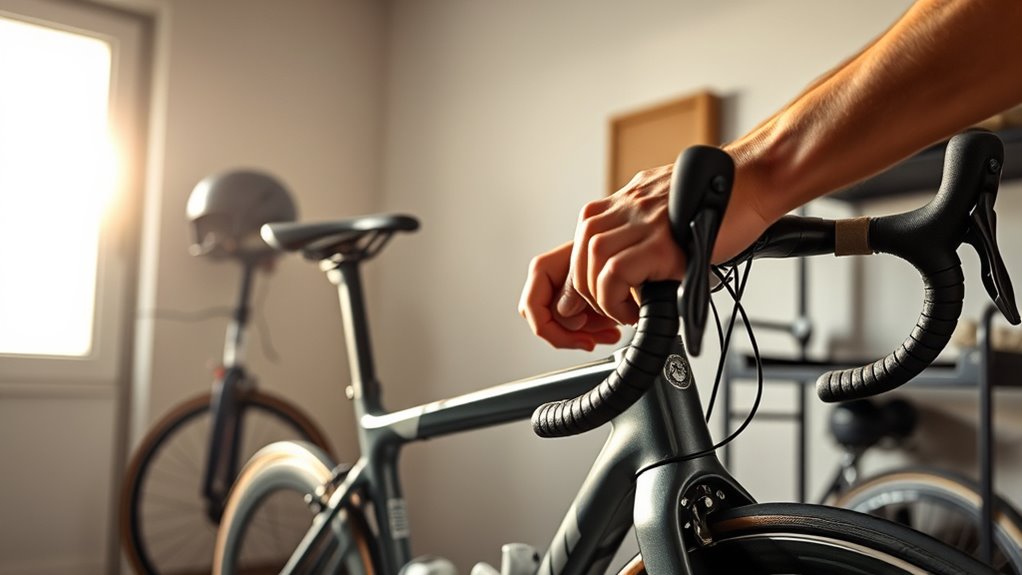
When you buy a new bike, ensuring it fits your body properly is the first step toward a comfortable and efficient ride. Start by verifying the frame size, making sure the geometry matches your proportions, even if the label says it’s the correct size. Properly fitting your bike also involves considering ergonomic positioning, which can greatly influence your overall comfort and performance. Focus on critical adjustments like seat height, stem length, and handlebar reach to optimize your riding position. Proper setup reduces the risk of injury by distributing weight evenly and maintaining alignment. It also boosts performance by maximizing power transfer and pedaling efficiency. Consider your riding style and goals—whether racing, commuting, or long-distance—to customize saddle tilt, gear ratios, and weight distribution. Document your body measurements and bike specs to establish a baseline for future adjustments and improvements. Additionally, paying attention to proper fit techniques can significantly enhance comfort and prevent common issues such as saddle soreness or back pain. Recognizing the importance of bike fitting can help you identify when to seek professional help for optimal results. Consulting with a professional bike fitter can provide personalized insights tailored to your unique body and riding needs. Moreover, an accurate fit can also help alleviate discomfort caused by improper bike setup, contributing to a more enjoyable riding experience.
Noticing Changes in Your Body or Flexibility

Changes in your flexibility or body composition can substantially influence your bike fit, making regular assessments essential. As your flexibility changes—whether from aging, injury recovery, or increased mobility efforts—your ideal riding position may shift. Incorporating digital literacy into your health routine can help you access online resources and tutorials for self-assessment and improvement. Some fitters perform range of motion tests to evaluate flexibility, but others rely on how you feel on the bike, since your natural position adjusts with your mobility. Pre-fit stretching can improve joint flexibility and alter fit results. Additionally, body weight changes or muscle imbalances can affect comfort and efficiency, often requiring adjustments. Recognizing personal health trends through regular check-ins can help you stay aware of how your body responds to different riding conditions. Keep in mind that ongoing flexibility and body changes mean your bike fit isn’t a one-time fix. Regular check-ins ensure your setup remains comfortable, efficient, and aligned with your current body condition.
Preparing for Long-Distance or Competitive Events

Preparing for long-distance or competitive cycling events requires careful biomechanical adjustments and equipment customization to maximize performance and reduce injury risk.
Long rides demand optimized weight distribution to lessen pressure on your hands, feet, and saddle, preventing fatigue.
For competitive events, focus on aerodynamics and power transfer efficiency by adjusting handlebar reach and crank length.
Pedal stroke analysis helps eliminate wasted energy during endurance efforts, while tailored cleat positioning prevents knee strain on climbs.
Adjust saddle height and setback to avoid hip or lower back fatigue over hours.
Equipment tweaks, such as changing crank length or handlebar shape, improve efficiency and comfort.
Ensure your setup is refined through data-driven insights and follow-up adjustments, so you stay comfortable and perform at your best during these demanding events.
Transitioning to a Different Cycling Discipline

Switching to a different cycling discipline involves significant adjustments to your bike fit to optimize comfort and performance. Different disciplines like road, triathlon, or mountain biking demand unique bike setups, body positions, and equipment choices.
Adapting your bike fit for a new discipline enhances comfort, efficiency, and performance.
For example, triathlon bikes require a highly aerodynamic posture, while mountain bikes focus on control and maneuverability. Moving into a new discipline may mean adjusting saddle height, handlebar position, and seat angle to suit the new riding demands.
Cleat placement and component swaps might also be necessary to improve efficiency and comfort. Your body’s flexibility and muscle strength should be considered, as some disciplines demand more aerodynamic positions that can be challenging to adopt.
A professional bike fitting ensures your setup aligns with the new discipline’s requirements, reducing injury risk and maximizing performance.
Noticing Reduced Power or Efficiency
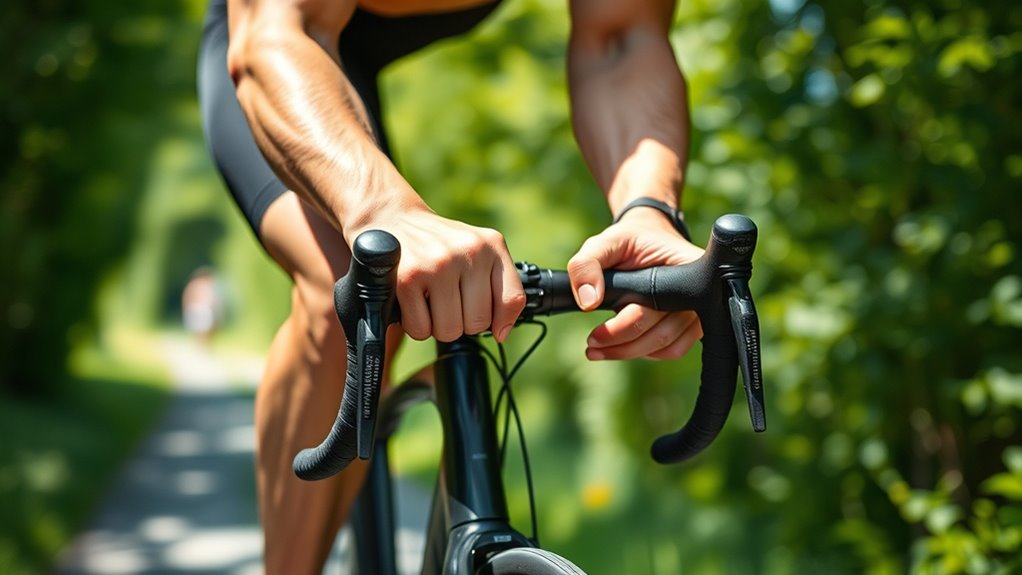
If you notice a sudden or persistent drop in your power output, it’s a sign that something in your bike fit or biomechanics may be off.
You might struggle to maintain previous FTP levels during workouts, and your perceived exertion could feel higher at the same power.
Power meter data may reveal inconsistent efficiency metrics, like pedal smoothness dropping below 55%.
You could also notice compensatory muscle activation patterns through biomechanical analysis, indicating inefficiencies.
Asymmetric pedal strokes or excessive knee movement often point to fit issues.
Equipment mismatches, such as incorrect crank length or saddle position, can also limit power.
Additionally, early muscle fatigue and joint discomfort suggest your setup isn’t supporting ideal performance.
Addressing these signs with a professional fit can restore your efficiency and power output.
Developing Numbness or Tingling in Limbs
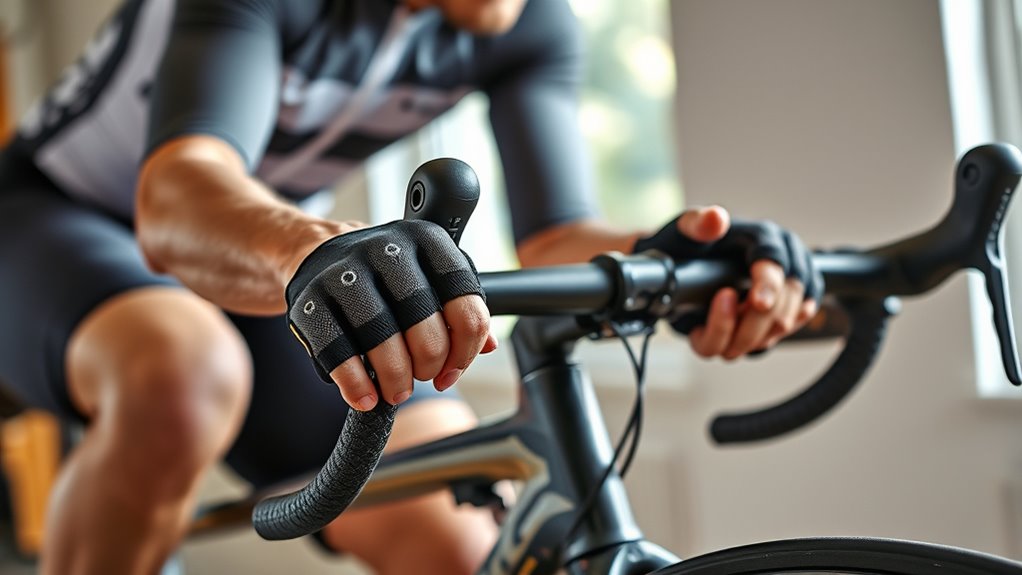
Developing numbness or tingling in your limbs during cycling often signals that your bike fit or equipment setup may be causing nerve compression. You might notice tingling in your toes or hands, burning foot pain, or hand weakness.
Numbness or tingling during cycling may indicate nerve compression from your bike setup.
These symptoms usually result from prolonged pressure on nerves or blood vessels, often due to cleat misalignment, handlebar pressure, or wrist hyperextension. For example, forward cleats increase toe pressure, and excessive handlebar grip can compress ulnar nerves, leading to “handlebar palsy.”
If symptoms persist beyond 30-60 minutes or recur regularly, it indicates that your setup isn’t ideal. Self-assessment, like adjusting cleat position, handlebar grip, and wrist angle, can help.
However, persistent issues warrant a professional bike fit to prevent long-term nerve damage and improve riding comfort.
Changing Saddle or Handlebar Setup
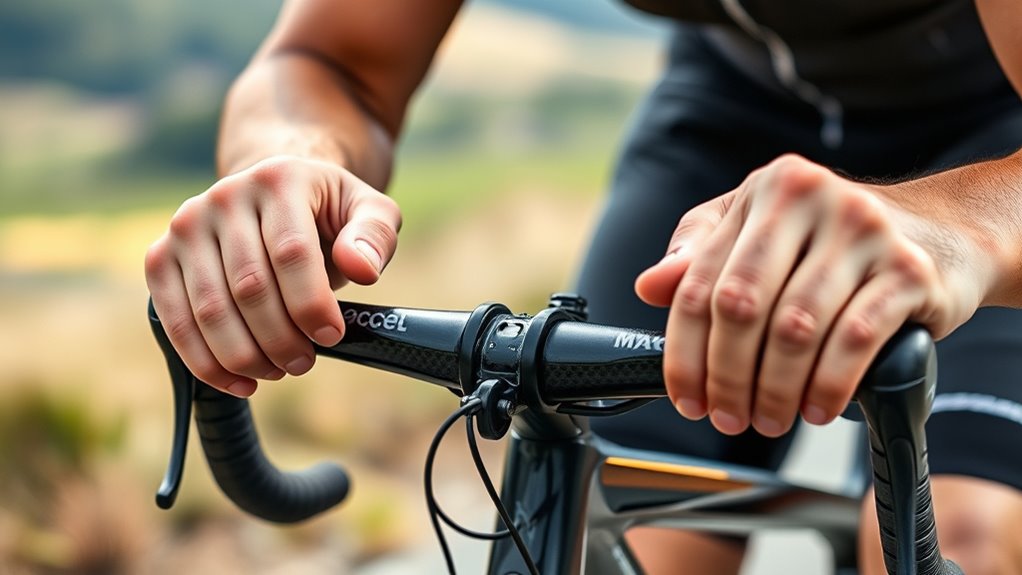
Adjusting your saddle or handlebar setup is a critical step toward enhancing comfort and performance on your bike. If you experience persistent saddle sores, knee tracking issues, or can’t find a neutral pelvic position despite DIY tweaks, it’s time to seek expert help.
Similarly, if your handlebar position causes excessive wrist bending, difficulty reaching brakes, or if stem angles or headset spacers push your posture beyond safe limits, professional adjustment is needed. Mismatched handlebar widths or incompatible components, like saddle rails or proprietary parts, can also hinder your ride.
These issues often stem from improper setup that can’t be fixed through simple tweaks. A professional bike fitter can assess your biomechanics and equipment to optimize your saddle and handlebar positions for comfort, efficiency, and injury prevention.
Recovering From an Injury or Physical Limitation
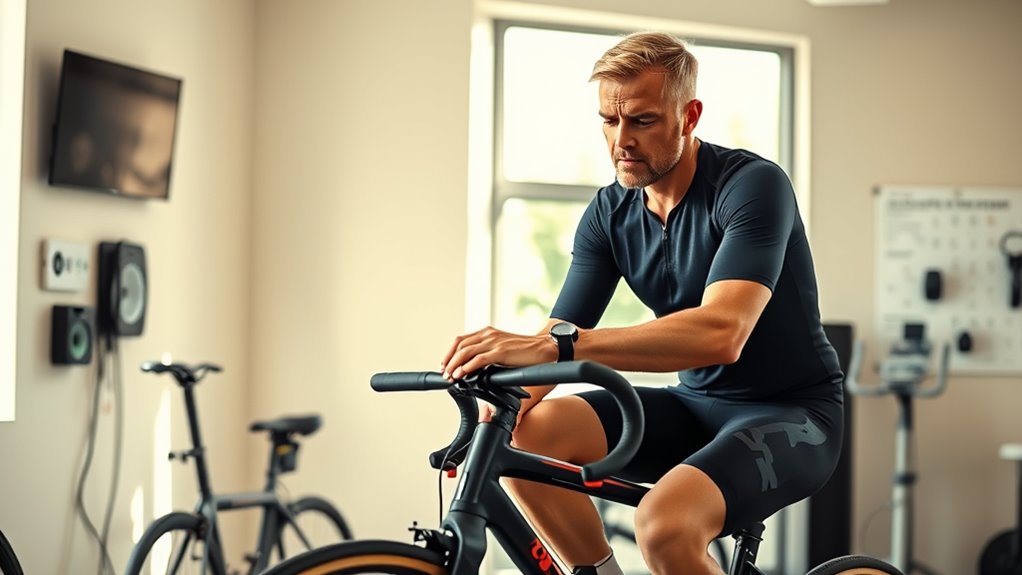
Recovering from an injury or managing a physical limitation requires careful attention to your bike setup to guarantee safety and promote healing. Proper bike fitting ensures a biomechanically neutral position, reducing strain on injured areas and preventing further damage.
It can alleviate pain by adjusting the bike to accommodate your specific limitations, such as spinal curvature or joint issues. Bike fitting also serves as a critical part of rehabilitation, helping you return to cycling safely and comfortably.
Adjustments tailored to your needs can prevent compensatory movements that may cause additional injuries. Over time, a professional fit promotes long-term comfort and improved performance, even as your body heals or adapts.
This careful approach supports both recovery and the prevention of new issues down the line.
Wanting to Optimize Performance and Comfort
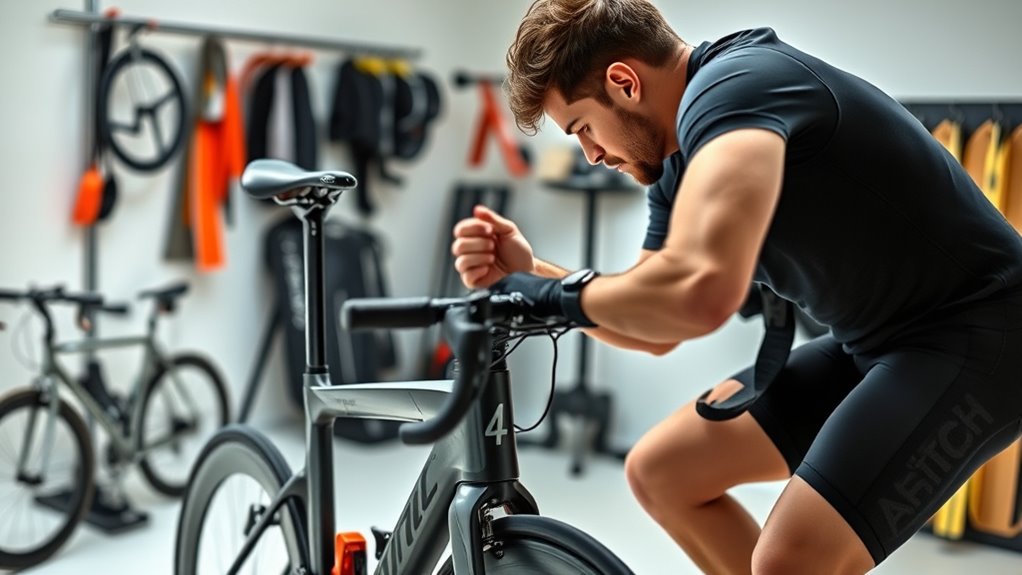
Optimizing your bike fit to enhance performance and comfort can make a significant difference in how you ride. Advanced fittings use high-tech tools like 3D motion capture and pressure mapping to fine-tune every detail.
If you’re aiming to boost speed, power, or aerodynamics, these fittings analyze your biomechanics in real time to make precise adjustments. You might also get recommendations for custom saddles or insoles tailored to your needs.
This investment, though pricier, guarantees maximum efficiency on longer rides and reduces the risk of injury by aligning your body correctly. Whether you’re riding road, triathlon, or mountain bikes, specialized technology helps optimize your position for comfort and performance.
With ongoing support, a professional bike fit can elevate your riding experience and help you reach your goals.
Frequently Asked Questions
How Often Should I Get a Professional Bike Fitting?
You should get a professional bike fitting at least once a year, especially if you ride over 2,000 miles annually. Regular check-ins help prevent discomfort, improve performance, and accommodate any body changes like weight fluctuations or flexibility improvements.
If you experience pain or notice riding inefficiencies, it’s a good time for a reassessment. Keep track of physical changes and training intensity to know when a new fitting is needed.
Can a Bike Fit Fix Persistent Knee Pain?
Did you know that bike fitting can markedly reduce knee pain over time?
If you experience persistent knee discomfort while cycling, a professional bike fit could be the solution. It’s not just about adjusting seat height or alignment; it optimizes your knee’s position, distributes workload evenly, and minimizes strain.
With proper fitting, you can enjoy longer, more comfortable rides and potentially eliminate chronic knee pain altogether.
Does a Bike Fitting Improve Cycling Performance?
A bike fitting can definitely improve your cycling performance. It optimizes your position for better muscle recruitment, increasing power output and efficiency. Plus, it reduces discomfort and fatigue, helping you ride longer and faster.
Proper alignment prevents injuries and ensures consistent effort, especially during races or long rides. By fine-tuning your setup based on data and your individual needs, you’ll perform at your best and reach new personal goals.
Is a Professional Fit Necessary for Casual Riding?
You might wonder if a professional bike fit is necessary for casual riding. The truth is, it can substantially improve your comfort and reduce injury risk, even if you ride occasionally.
A tailored fit ensures your bike matches your body, making rides more enjoyable and efficient.
Investing in a professional fit helps you ride longer and more comfortably, enhancing your overall cycling experience, regardless of how often you hit the road.
How Long Does a Typical Bike Fitting Session Take?
A bike fitting session is like tuning a fine instrument—you want precision and harmony. Typically, it lasts around 2 to 2.5 hours, but a complete fit can take up to 3.5 hours.
You’ll start with a consultation, followed by on-bike adjustments and tech analysis. Prepare to dedicate some time for ideal comfort and performance, as this investment pays off on every ride.
Conclusion
If you notice persistent discomfort, numbness, or recent changes in your body, it’s time to see a professional bike fitter. For example, imagine a cyclist experiencing tingling in their hands every ride — a proper fit could resolve this and boost comfort. Investing in a professional fitting guarantees you enjoy longer, pain-free rides and perform at your best. Don’t wait until pain limits your cycling — get fitted and ride smarter today.
